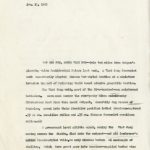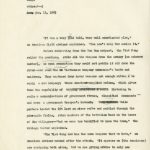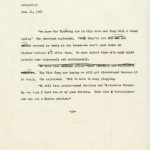1965, January 11, “Miniature Invasion”
deepe
outpost–1
jan. 11, 1965
TAN BUB BUU, SOUTH VIET NAM–Only ten miles from Saigon‘s gleaming white Presidential Palace last week, a Viet Cong Communist unit momentarily adopted Korean War-styled tactics of a miniature invasion instead of following their usual elusive guerrilla tactics.
The Viet Cong unit, part of the five-hundred-man reinforced battalion, scampered across the rice-paddy dikes outsideonly fivehundred feet from this small outpost, carefully dug dozens of foxholes, moved into their frontline position lethal American-captured .57 ml mm. recoilles rifles and .75 mm. Chinese Communist recoiless rifles.and
A government local militia squad, seeing the Viet Cong moving across the fields, fled into the outpost–and old landowner’s villas French-styled villa,–only minutes before ana [Booming?] onslaught of shelling, which tore great gaps into the American-supplied barbed wire fences, ripped the front through the front concrete wall and smashed into the front door.
deepe
outpost–2
jan. 11, 1965
Minutes later, the Viet Cong troopers sneaked through the holes in the wall, sending the government company and local mil defenders “retreating in blood,” as one of them explained. An American officer die was killed h near k the smicic semicircular foxhold near the front gate, after expending four boxes of ax machinegun ammunition which dea delayed the Viet Cong advance.
An American sergeant, one of the 20 wounded, escaped by jumping into the river and hiding until the VietCong retreated two hours later.
Simultaneously, other elements of the Viet Cong reinforced battalion launched four three other devr diversionary attacks. More than 100 Viet Cong attacked another pacified hamlet north of Tan Buu, while others atta cked southern outposts harassed with mortar fire two southern outposts on the south, and others attacked the neighboring positions la unched 25 rounds of deadly .81 mm. mortar rounds into artillery position in neighboring Binh Chanh district headquarters. One round crashed through roof of thr austere district headquarters and one exploded outside National Police Headquarters where 10 district police officials barely escaped injury. Several landed only 20 yearsyards from the green temporary hut of the five-man American advisory district advisory team.
deepe
outpost–3
han.jan. 11, 1965
“It was a very gold bold, very well coordinated plan,” an American field advisor explained. “You can’t help but admire it.”
Before retreating from the Tan Buu outpost, the Viet Cong raided the premises, stole all the weapons from the armory (an unknown number), carried away so much ammunition they could not paddle it all down the river–and even swiped the co Vietnamese company commander’s boots and uniforms. They captured four heavy weapons and enough rifles f to equip a new company; three American-supplied radios, which gives them the capability oftapping government o radiolistening to radio c communications of government forces, classified documents–and even a government trooper’s hammock. They loaded While porters loaded the lot loot on river rafts and paddled through the pineapple fields, other members of the battalion beat on the doors of the villagers–“but we were too terrified to open the door,” the village barber explained.
“The Viet Cong now has the same weapons that we have,” an American advisor moaned after the attack. “It appears we (the Americans) are equipping both sides, but we are giving advice to only one side.”to see if the advice is effective.”
(More)
deepe
outpost–4
jan. 11, 1965
The Viet Cong attack, vis clearly audible in Saigon, sent wealthb wealthy businessmen x tossing in their beds, and the following day sent Vietnamese mil and American military commanders adding red dots (indicating Viet Cong attacks) to their maps in a 25-mile arc around the capital city.
The attack, was made in the presumably pacified area of the strategically-important Hoc-TopHop Tac (Cooperation) Plan, designed by Gen. William C. Westmoreland, ca Commander of the American Military Assistance Command, and approved by American Secretary of Defense Robert McNamara last fall.
The plan, using Saigon as the center of the so-called “oil spot”, calls for the gradual expansion of government authority into the provincial area six provinces around Saigon.
“There’s no doubt in my mind that the Viet Cong will attack us more and more in the Hoc TopHop Tac area,” one American advisor explained.
“The Viet Cong were very clever in attackm attacking clusters of hamlets and outposts that were in different provinces and districts. Within one and a half miles, our border here intersects the neighboring province in six different places inon the roadmain Highway and the canals. It adds to the confusion and hinders coordination as to who should send in reinforcements.
deepe
outpost–5
jan. 11, 1965
“we know the Viet|Cong are in this area and they will a ttack again,” the American explained. “Buty they’re not amm amm ana amased amassed in tents in the trees–we can’t send tanks or fighter bombers a f after them. We must defeat them with many night patrols done vigorously and continuously.
“We will lose many g people–good American and Vietnamese soldiers. “The Viet Cong are hoping we will get discouraged because it is tough, “he explained. “But we have to keep plugging.
“We will lose people–good American and Vietnamese troops. In two days I lost two of my good friends. Both were E Westpointers and one was a Rhodes scholar.”
-30-
Read Next Article: 1965, January 18, “Vietnamese Intelligence Officials, Unconfirmed Reports”





